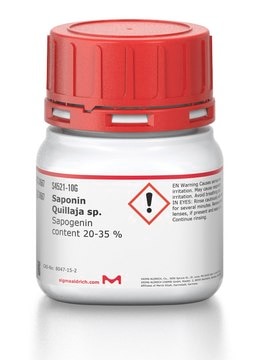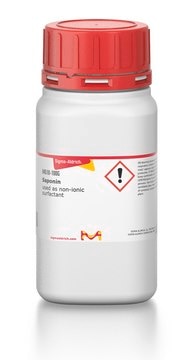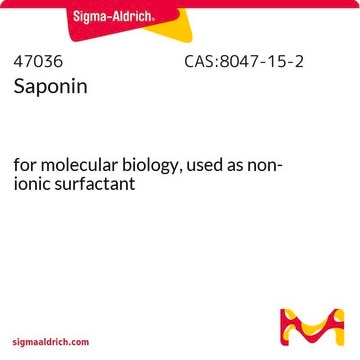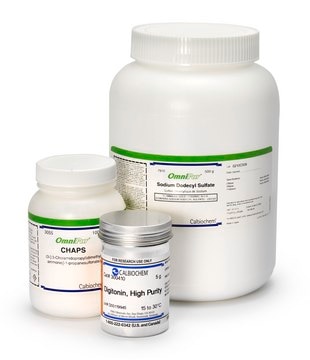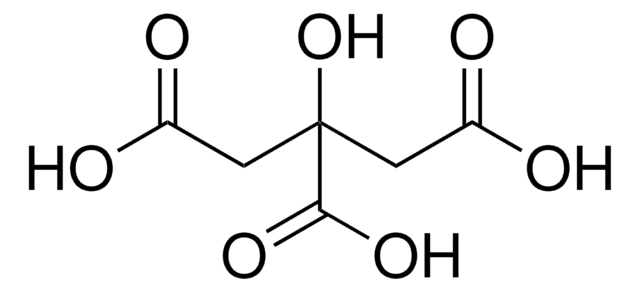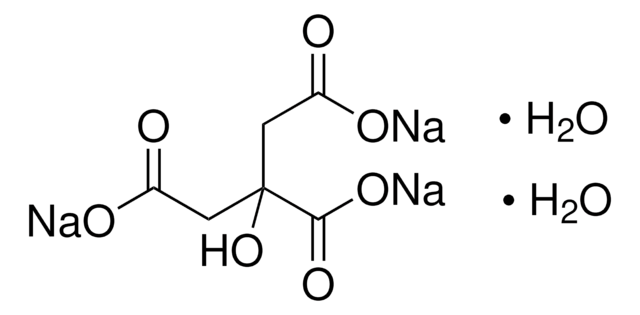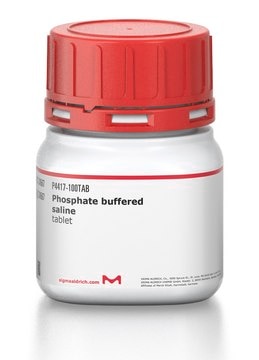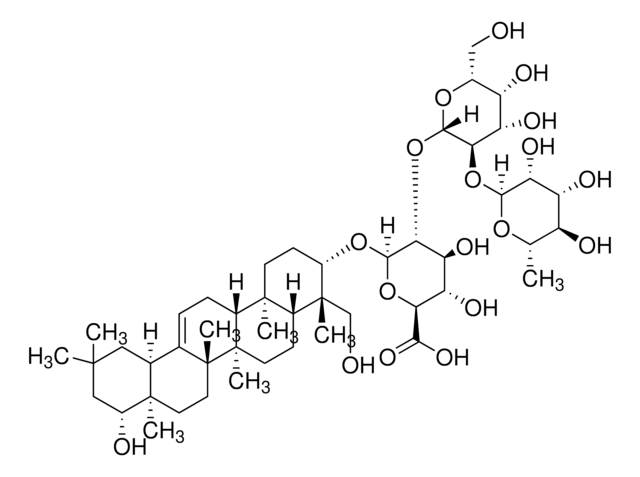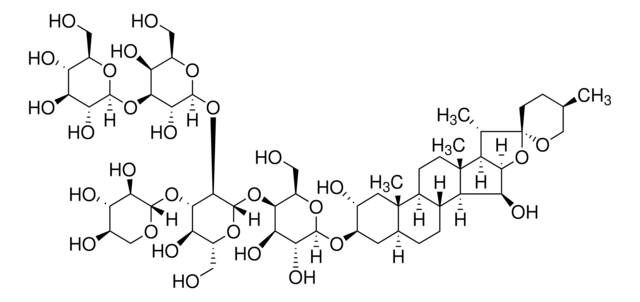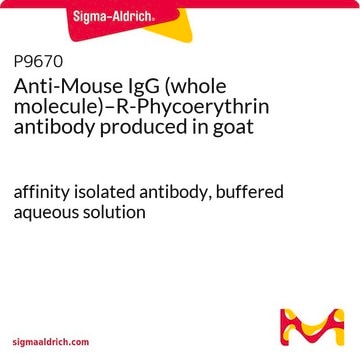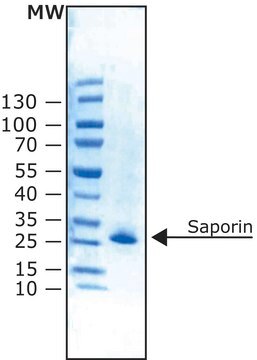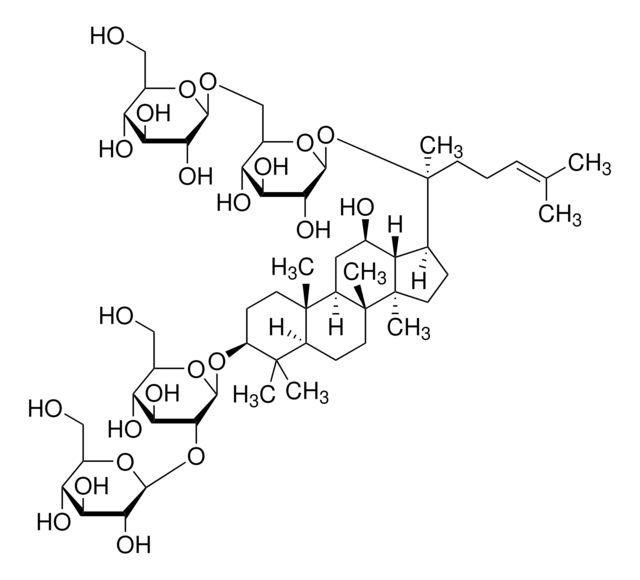S7900
Saponin from quillaja bark
Sapogenin content ≥10 %
Sign Into View Organizational & Contract Pricing
All Photos(2)
About This Item
Recommended Products
description
non-ionic
Quality Level
composition
Sapogenin content, ≥10%
technique(s)
HPLC: suitable
protein quantification: suitable
sulfated ash
<20%
Looking for similar products? Visit Product Comparison Guide
Related Categories
General description
Saponins are natural steroidal glycoside (terpenes).
Application
Saponin from Quillaja bark has been used:
- to stain CD4+ and CD8+ T-cells
- to lyse trophozoite-infected red blood cells
- in immunohistochemical staining
Biochem/physiol Actions
Saponins are associated with many biological and pharmacological activities. It is known to stimulate immune response in mammals. Hence it is used as vaccine adjuvants. Saponins possesses antiviral, antifungal, antitumor, anti-inflammatory, hypoglycemic and hypocholesterolemic effects.
Saponins solubilize the low density lipoprotein (LDL) fraction of cholesterol in micelles, thus lowering their concentration. Saponin from Quillaja bark is used as a flavoring agent in food and beverages. This saponin has been shown to enhance immune-cell proliferation in vitro.
Potent hemolytic when injected i.v.; surfactant that enhances penetration of proteins and other macromolecules through cell membranes; it also has been used as an adjuvant for vaccines.
signalword
Warning
hcodes
Hazard Classifications
Eye Irrit. 2 - STOT SE 3
target_organs
Respiratory system
wgk_germany
WGK 2
flash_point_f
Not applicable
flash_point_c
Not applicable
ppe
dust mask type N95 (US), Eyeshields, Gloves
Certificates of Analysis (COA)
Search for Certificates of Analysis (COA) by entering the products Lot/Batch Number. Lot and Batch Numbers can be found on a product’s label following the words ‘Lot’ or ‘Batch’.
Already Own This Product?
Find documentation for the products that you have recently purchased in the Document Library.
Customers Also Viewed
Metabolite profiling of the intraerythrocytic malaria parasite Plasmodium falciparum by (1)H NMR spectroscopy.
Teng R
Nmr in Biomedicine, 22(3), 292-302 (2009)
Induction of human papillomavirus-specific CD4(+) and CD8(+) lymphocytes by E7-pulsed autologous dendritic cells in patients with human papillomavirus type 16- and 18-positive cervical cancer.
Santin AD
Journal of Virology, 73(7), 5402-5410 (1999)
Natalie J Spillman et al.
Molecular and biochemical parasitology, 162(1), 96-99 (2008-08-05)
The intraerythrocytic malaria parasite, Plasmodium falciparum maintains an intracellular pH (pH(i)) of around 7.3. If subjected to an experimentally imposed acidification the parasite extrudes H(+), thereby undergoing a pH(i) recovery. In a recent study, Bennett et al. [Bennett TN, Patel
Effect of testosterone on insulin stimulated IRS1 Ser phosphorylation in primary rat myotubes--a potential model for PCOS-related insulin resistance.
Allemand MC
PLoS ONE, 4(1), e4274-e4274 (2009)
Joo Young Park et al.
Journal of hazardous materials, 163(2-3), 761-767 (2008-08-12)
The applicability of microbubble suspension made of saponin as a biodegradation-enhancing carrier where oxygen and pollutant-degraders are limited was studied. The saponin-microbubble suspension was used to deliver phenanthrene-degrading bacteria, inorganic nutrients, and oxygen. Bench-scale study was carried out to determine
Our team of scientists has experience in all areas of research including Life Science, Material Science, Chemical Synthesis, Chromatography, Analytical and many others.
Contact Technical Service